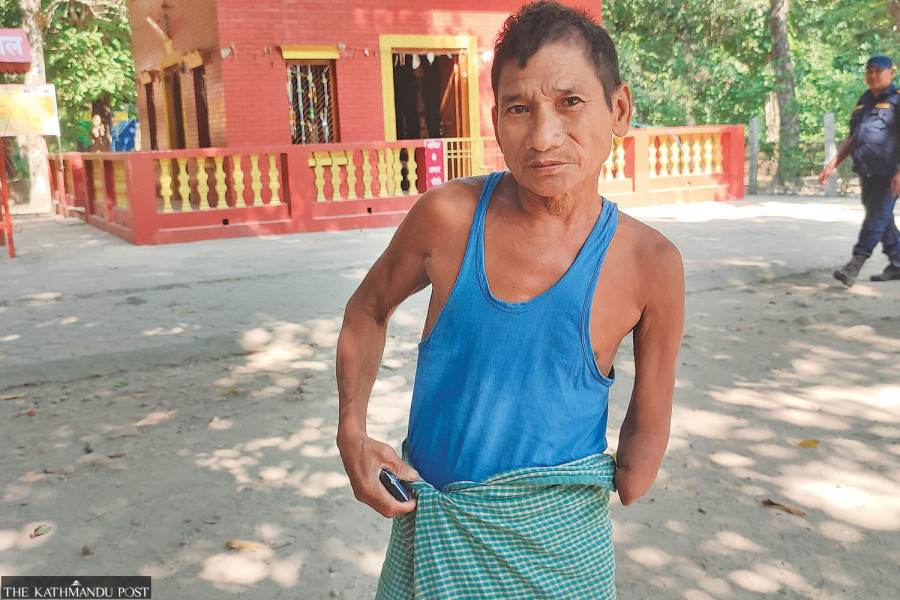Bagmati Province
Balmiki Ashram, settlement nearby remain neglected
Local residents say authorities have paid no heed to the conservation of the historically important site and providing facilities to them.
Ramesh Kumar Paudel
One day in July, 1997, Mangal Bahadur Chidi Magar, a permanent resident of Balmiki Ashram area in Chitwan, was on his way to the Indian marketplace with two of his nephews through the dense forest when he had an encounter with a bear.
He swiftly helped his small nephews climb a nearby tree. But the bear, accompanied by its cubs, attacked him as he attempted to climb the tree.
“The bear clutched my back,” Mangal, then 30 years old, recalls. “I attempted to punch the bear’s nose with my left hand. But the bear bit my hand. Then I didn’t know what happened.”
Mangal regained consciousness on a hospital bed. Some Bolbam devotees had known about the incident and rushed him to the hospital where he stayed for three months. His left hand below the elbow had to be amputated.
Mangal’s hut is near the Balmiki Ashram, a famous Hindu shrine, in the western corner of Chitwan National Park. The place obviously has religious and historical significance but the area is surrounded by forests. It is very remote and so the threat of wild animals is high.
Ten families have been living near Balmiki Ashram over the past five decades. According to the then king Mahendra Shah’s plan to set up settlement of the people of hilly origin near Nepal-India border in 1960s, some Magar families were brought to Balmiki Ashram from Tanahun district. Mangal’s parents, however, had come all the way from Palpa and settled there.
Legend has it that Balmiki, writer of the Hindu epic Ramayan, made his Ashram in the area and stayed there for several years. There are two temples in the area. Archaeologically important ruins including bricks, stone pillars, statues and other artistic structures are scattered on the temple premises. There is a stone pillar which is believed to have been used by Laba and Kusha, the twin sons of Goddess Sita, in tying a horse and various other religiously important places on the premises of Balmiki Ashram.
Both the Ashram area and the human settlement nearby are left neglected. The local people complained that the government is indifferent to the conservation of the Balmiki Ashram area. The area does not have electricity and drinking water facilities, said Ram Sharan Giri, priest of the temple situated in Balmiki Ashram. “The local people living here for such a long time do not have land ownership certificates,” Giri added. He complained that the authorities concerned have paid no heed to the conservation of the religiously and historically important place and providing facilities to the local people.
Mangal, who lost his left hand in the bear attack, has faced a similar fate. The wild animals from Chitwan National Park and India’s Valmiki Tiger Reserve—which is around 300 metres away from Balmiki Ashram—frequently enter the settlement and attack people.
The local people are still dependent on the Indian town of Bhaisalotan Valmikinagar to buy essential commodities. One has to walk around a seven-kilometre-long road that passes through Valmiki Tiger Reserve forest on the Indian side. Besides the risks of wildlife, India’s Seema Suraksha Bal (SSB) personnel frequently harass them on various pretexts.
“Mangal lost his hand and the local people have to endure various hardships,” said Giri, the priest. “The government neither thinks about the hardships of the local people nor takes any concrete initiatives to preserve such an important site.”
Balmiki Ashram lies in ward 1 of Madi Municipality, Chitwan. The devotees and tourists who want to visit the Ashram have to travel through the Indian side. A foot bridge was built in Tribeni two years ago but it remains unused as there is no way to reach Balmiki Ashram through Chitwan National Park.




 13.12°C Kathmandu
13.12°C Kathmandu1.jpg)











